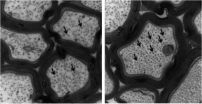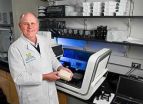Lastest graphene research could lead to improvements in bluetooth headsets and other devices
Researchers at the University of California, Riverside continue advancements with graphene, the single-atom thick carbon crytal that was the subject of this year's Nobel Prize in physics
2010-10-19
(Press-News.org) RIVERSIDE, Calif. (www.ucr.edu) – Researchers at the UC Riverside Bourns College of Engineering have built and successfully tested an amplifier made from graphene that could lead to more efficient circuits in electronic chips, such as those used in Bluetooth headsets and toll collection devices in cars.
Graphene, a single-atom thick carbon crystal, was first isolated in 2004 by Andre Geim and Konstantin Novoselov, who won the Nobel Prize in physics this month for that work. Graphene has many extraordinary properties, including superior electrical and heat conductivity, mechanical strength and unique optical absorption.
The demonstration at UCR of the graphene amplifier with signal processing functions is a major step forward in graphene technology because it is a transition from individual graphene devices to graphene circuits and chips, said Alexander Balandin, a professor of electrical engineering, who performed the work along with a graduate student and researchers at Rice University.
The triple-mode amplifier based on graphene has advantages over amplifiers built from conventional semiconductors, such as silicon, said Balandin, who is also chair of the UC Riverside Materials Science and Engineering program. The graphene amplifier reveals greater functionality and a faster speed because of graphene's electrical ambipolarity (current conduction by negative and positive charges).
It can be switched between different modes of operation by a simple change of applied voltage. These characteristics are expected to result in simpler and smaller chips, a faster system response and less power consumption.
The experimental demonstration of the graphene amplifier functionality was reported last week in the journal ACS Nano.
The fabrication and experimental testing were performed in Balandin's Nano-Device Laboratory. The co-authors of the paper are Guanxiong Liu, one of Balandin's graduate students, Kartik Mohanram, an assistant professor at Rice University, and Xuebei Yan, one of Mohanram's graduate students.
The researchers from Rice University designed the amplifier and testing protocol. Liu built the device in the UCR clean room. Liu and Yan then tested the amplifier in Balandin's lab.
The triple-mode amplifier can be charged at anytime during operation in the three modes: positive, negative or both. By combining these three modes, the researchers demonstrated the amplifier can achieve the modulation necessary for phase shift keying and frequency shift keying, which are widely used in wireless and audio applications.
These applications include: Bluetooth headsets for cell phones; radio frequency identification (RFID), which is used in wireless products, including toll collection devices in cars, cards used to pay for public transportation and identification tags on animals; and ZigBee, a communication protocol used in devices such as such as wireless light switches with lamps and electrical meters with in-home-display.
INFORMATION: END
ELSE PRESS RELEASES FROM THIS DATE:
2010-10-19
Cold Spring Harbor, NY -- A team co-led by neuroscientists at Cold Spring Harbor Laboratory (CSHL) has shed light -- literally -- on circuitry underlying the olfactory system in mammals, giving us a new view of how that system may pull off some of its most amazing feats.
It has long been known from behavioral experiments that rodents, for instance, can tell the difference between two quite similar odors in a single sniff. But in such instances, what precisely happens in the "wiring" leading from sensory neurons in the nose to specialized cells in the olfactory bulb ...
2010-10-19
When the storm winds blow, wind turbines have to show what they can stand up to. The wind blows hard against mills with the force of tons as the tips of the blades plow through the air at more than 200 kilometers per hour. But natural forces not only tear at wind turbines; machine components made of plastic or airplane wings must with stand substantial loads as well.
These days, we normally use sensors to measure whether these components are strained beyond capacity, and it requires a lot of effort to install them into the component parts or glue them onto their surface. ...
2010-10-19
ANN ARBOR, Mich. — Pediatric health care work force planning efforts are increasingly incorporating the roles of nurse practitioners and physician assistants, especially in plans to alleviate the perceived shortage of pediatric subspecialists.
However, results from four new studies of pediatric nurse practitioners, family nurse practitioners, neonatal nurse practitioners, and pediatric physician assistants published online today in the journal Pediatrics do not seem to support that idea. The work was conducted by the University of Michigan's Child Health Evaluation and ...
2010-10-19
PHILADELPHIA – Finding a drug that can cross the blood-brain barrier is the bane of drug development for Alzheimer's disease and other neurological disorders of the brain. A new Penn study, published this week in the Journal of Neuroscience, has found and tested in an animal model of Alzheimer's disease a class of drug that is able to enter the brain, where it stabilizes degenerating neurons and improves memory and learning.
In the normal brain, the protein tau plays an important role in stabilizing structures called microtubules in nerve cells, which serve as tracks ...
2010-10-19
OAK RIDGE, Tenn., Oct. 18, 2010 -- Theoretical work done at the Department of Energy's Oak Ridge National Laboratory has provided a key to understanding an unexpected magnetism between two dissimilar materials.
The results, published in Nature Communications, have special significance for the design of future electronic devices for computations and telecommunications, according to co-author Satoshi Okamoto of ORNL's Materials Science and Technology Division. The work was performed at Universidad Complutense de Madrid, synchrotron radiation facilities in France and Japan, ...
2010-10-19
ANN ARBOR, Mich. — Scientists at the University of Michigan Heath System and their collaborators have found four new DNA "hotspots" that may one day help guide new treatments for psoriasis, one of the most common autoimmune diseases in the country.
Using cutting-edge methods to peer into the hidden genetic underpinnings of the disabling and disfiguring disease, the research, published in Nature Genetics, further maps the as-yet unknown territories of psoriasis and psoriatic arthritis.
The findings could lead to new drug targets and tailored treatments for the skin ...
2010-10-19
Tampa, Fla. (October 18, 2010) –Two research teams from the Okayama University Graduate School of Medicine (Okayama, Japan) have reported breakthrough studies in liver cell transplantation. One team found that the technical breakthrough in creating induced pluripotent stem cells (iPS) from mouse somatic cells (nonsex cells) in vitro had "implications for overcoming immunological rejection." Whereas a second team using liver cell xenotransplantation - transplanting cells of one species into another (in this case transplanting pig liver cells into mice) - found that transplanted ...
2010-10-19
MAYWOOD, Ill. -- Vitamin D deficiency is associated with a significant increase in lung transplant rejection, according to research conducted at Loyola University Health System (LUHS). These data were presented Monday at The American Society for Bone and Mineral Research 2010 annual meeting in Toronto, Ontario.
"Vitamin D deficiency is prevalent among lung transplant recipients," said Pauline Camacho, MD, study investigator and director of the Loyola University Osteoporosis and Metabolic Bone Disease Center. "This study shed greater light on the serious impact that this ...
2010-10-19
The next time you feel your willpower slipping as you pass that mouth-watering dessert case, tighten your muscles. A new study in the Journal of Consumer Research says firming muscles can shore up self-control.
Authors Iris W. Hung (National University of Singapore) and Aparna A. Labroo (University of Chicago) put study participants through a range of self-control dilemmas that involved accepting immediate pain for long-term gain. In one study, participants submerged their hands in an ice bucket to demonstrate pain resistance. In another, participants consumed a healthy ...
2010-10-19
Argonne, ILL—For the first time scientists have been able to watch nanoparticles grow from the earliest stages of their formation. Nanoparticles are the foundation of nanotechnology and their performance depends on their structure, composition, and size. Researchers will now be able to develop ways to control conditions under which they are grown. The breakthrough will affect a wide range of applications including solar-cell technology and chemical and biological sensors. The research is published in NANOLetters.
As coauthor Wenge Yang of the Carnegie Institution's ...
LAST 30 PRESS RELEASES:
[Press-News.org] Lastest graphene research could lead to improvements in bluetooth headsets and other devices
Researchers at the University of California, Riverside continue advancements with graphene, the single-atom thick carbon crytal that was the subject of this year's Nobel Prize in physics



